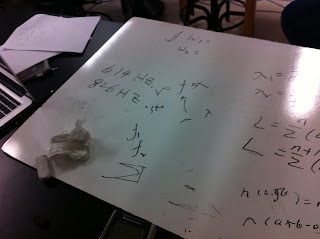Objective: Use the frequency of sound emitted by a swinging pipe to determine it's length using sound wave and standing wave equations.
Procedure:
1) Swing the pipe in a circle at a constant angular velocity in order to create a standing wave in the pipe. The frequency will be recorded using a digital microphone.
2) Accelerate the pipe until it emits the next harmonic frequency. This frequency will be recorded using the digital microphone.
3) Determine the length of the pipe using these two frequencies assuming that the speed of sound remains constant.
Calculations:
Omega equals to 3859 rad/s for the first case, so f-1 roughly equals to 614 hz; for the second case, omega = 5068 rad/s; thus, f-2 equals 806 hz.
n = harmonic number of lower frequency, L = wavelength
(2n + 1)(L1)/4 = (2n + 3)(L2)/4
L1 = v/f1 L2 = v/f2
(2n + 1)(f2) = (2n + 3)(f1)
n = 2.7 ~ 3
Length of pipe = (2n + 1)v/(4f1) = 0.978 (v = speed of sound assumed to be 343 m/s)


No comments:
Post a Comment